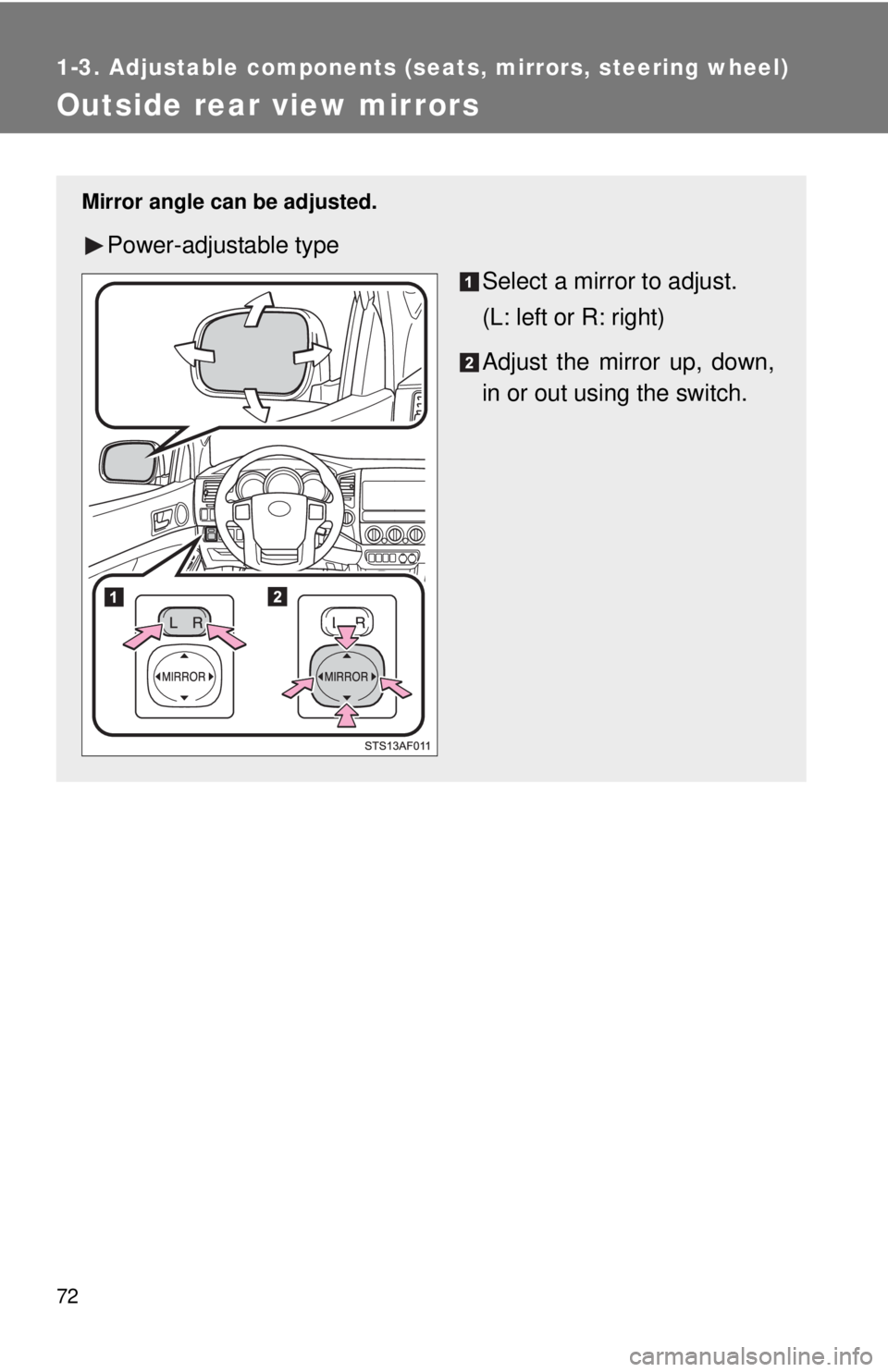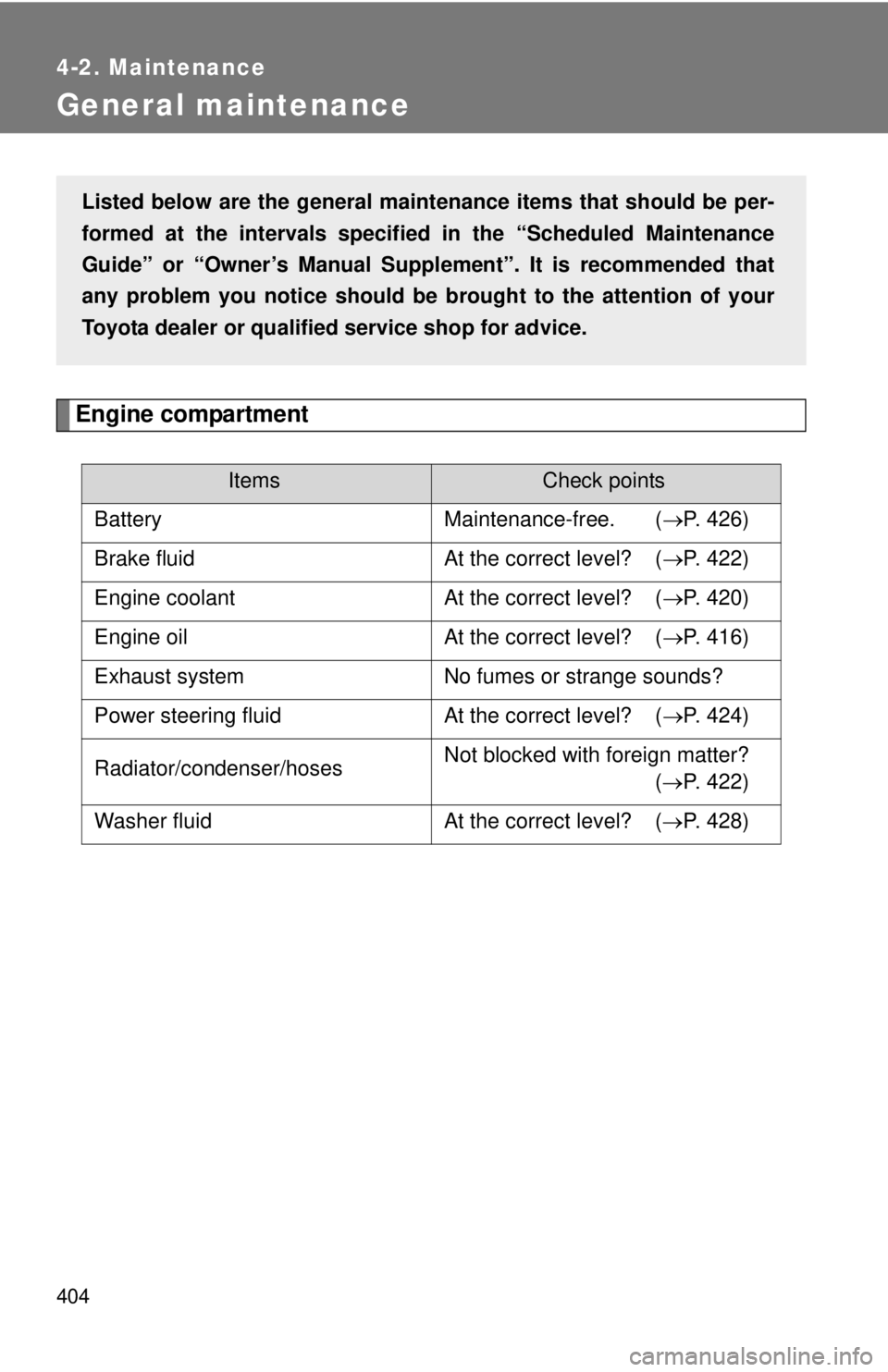power steering TOYOTA TACOMA 2014 Owners Manual (in English)
[x] Cancel search | Manufacturer: TOYOTA, Model Year: 2014, Model line: TACOMA, Model: TOYOTA TACOMA 2014Pages: 601, PDF Size: 11.67 MB
Page 2 of 601

TABLE OF CONTENTSIndex
2
1-1. Key informationKeys ..................................... 32
1-2. Opening, closing and locking the doors
Wireless remote control ....... 34
Side doors ............................ 37
Access doors (Access Cab models only) ....................... 41
Tailgate ................................ 42
1-3. Adjustable components (seats, mirrors, steering
wheel)
Front seats ........................... 47
Rear seats (Access Cab and Double Cab models) .......... 52
Head restraints ..................... 56
Seat belts ............................. 61
Steering wheel ..................... 67
Anti-glare inside rear view mirror .................................. 68
Outside rear view mirrors ..... 72
1-4. Opening and closing the windows
Power windows .................... 75
Back window (vehicles with sliding type) ........................ 77 1-5. Refueling
Opening the fuel tank cap..... 78
1-6. Theft deterrent system Engine immobilizer system ... 81
1-7. Safety information Correct driving posture ......... 84
SRS airbags ......................... 86
Front passenger occupant classification system ......... 100
Child restraint systems ....... 105
Installing child restraints ..... 109
2-1. Driving procedures Driving the vehicle .............. 130
Engine (ignition) switch....... 141
Automatic transmission ...... 144
Manual transmission........... 148
Turn signal lever ................. 151
Parking brake ..................... 152
Horn .................................... 154
2-2. Gauges and meters Gauges and meters ............ 155
Indicators and warning lights ................................. 158
1Before driving
2When driving
Page 31 of 601

Before driving1
31
1-1. Key informationKeys ................................... 32
1-2. Opening, closing and locking the doors
Wireless remote control ..... 34
Side doors .......................... 37
Access doors (Access Cab models only) .................... 41
Tailgate .............................. 42
1-3. Adjustable components (seats, mirrors, steering
wheel)
Front seats ......................... 47
Rear seats (Access Cab and Double Cab
models) ............................ 52
Head restraints................... 56
Seat belts ........................... 61
Steering wheel ................... 67
Anti-glare inside rear view mirror ....................... 68
Outside rear view mirrors ... 72 1-4. Opening and closing
the windows
Power windows .................. 75
Back window (vehicles with sliding type) .............. 77
1-5. Refueling Opening the fuel tank cap ................................... 78
1-6. Theft deterrent system Engine immobilizer system ............................. 81
1-7. Safety information Correct driving posture....... 84
SRS airbags ....................... 86
Front passenger occupant classification system ...... 100
Child restraint systems..... 105
Installing child restraints... 109
Page 72 of 601

72
1-3. Adjustable components (seats, mirrors, steering wheel)
Outside rear view mirrors
Mirror angle can be adjusted.
Power-adjustable type
Select a mirror to adjust.
(L: left or R: right)
Adjust the mirror up, down,
in or out using the switch.
Page 73 of 601

73
1-3. Adjustable components (s
eats, mirrors, steering wheel)
1
Before driving
Folding back the mirrors
Push backward to fold the mir-
rors.
Manually adjustable typeAdjust the mirror up, down, in
or out by pushing the mirror
surface.
■Mirror operating conditions (vehicle s with power-adjustable type only)
The engine switch is in the ACC or ON position.
Page 89 of 601

89
1-7. Safety information
1
Before driving
■
SRS warning light
This warning light system monitors the airbag sensor assembly, front airbag
sensors, side and curtain shield airbag sensor assemblies, curtain shield air-
bag sensor assemblies (Access Cab and Double cab models), driver’s seat
position sensor, driver’s seat belt buckle switch, front passenger occupant
classification system (ECU and sensors), AIR BAG ON and AIR BAG OFF
indicator lights, front passenger’s seat position sensor (Bench type seat),
front passenger’s seat belt buckle switch, front seat belt pretensioner
assemblies, belt tension sensor (Bench type seat), RSCA OFF indicator light
(4WD models only), airbags, interconnecting wiring and power sources.
(P. 485)
■ If the SRS airbags deploy (inflate)
●Bruising and slight abrasions may result from contact with a deploying
(inflating) SRS airbag.
● A loud noise and white powder will be emitted.
● Parts of the airbag module (steering wheel hub, airbag cover and inflator)
as well as the front seats, and parts of the front and rear pillars and roof
side rail, may be hot for several minutes. The airbag itself may also be
hot.
● The front windshield may crack.
■ Operating conditions (front airbags)
●The SRS front airbag will deploy in the event of an impact that exceeds
the set threshold level (the level of force corresponding to an approxi-
mately 12-18 mph [20-30 km/h] frontal collision with a fixed wall that does
not move or deform).
However, this threshold velocity will be considerably higher if the vehicle
strikes an object, such as a parked vehicle or sign pole, which can move or
deform on impact, or if the vehicle is involved in an underride collision (e.g.
a collision in which the front of the vehicle “underrides”, or goes under, the
bed of a truck, etc.).
Page 134 of 601

134 2-1. Driving procedures
CAUTION
■When driving the vehicle
●On vehicles with an automatic transmission, do not let the vehicle roll
backwards while the shift lever is in a driving position, or roll forward while
the shift lever is in R.
Doing so may cause the engine to stall or lead to poor brake and steering
performance, resulting in an accident or damage to the vehicle.
● If the smell of exhaust is noticed inside the vehicle, open the windows and
check that the back window is closed. Large amounts of exhaust in the
vehicle can cause driver drowsiness and an accident, resulting in death or
a serious health hazard. Have the vehicle inspected by your Toyota dealer
immediately.
● On vehicles with an automatic transmission, do not shift the shift lever to P
while the vehicle is moving.
Doing so can damage the transmission and may result in a loss of vehicle\
control.
● Do not shift the shift lever to R while the vehicle is moving forward.
Doing so can damage the transmission and may result in a loss of vehicle\
control.
● Do not shift the shift lever to D (vehicles with an automatic transmission) or
1 (vehicles with a manual transmission) while the vehicle is moving back-
ward.
Doing so can damage the transmission and may result in a loss of vehicle\
control.
● Moving the shift lever to N while the vehicle is moving will disengage the
engine from the transmission. Engine braking is not available when N is
selected.
● During normal driving, do not turn off the engine. Turning the engine off
while driving will not cause loss of steering or braking control, but the
power assist to these systems will be lost. This will make it more difficult to
steer and brake, so you should pull over and stop the vehicle as soon as it
is safe to do so.
However, in the event of an emergency, such as if it becomes impossible
to stop the vehicle in the normal way: P. 523
Page 139 of 601

139
2-1. Driving procedures
2
When driving
NOTICE
■
When driving the vehicle
●Do not depress the accelerator and brake pedals at the same time during
driving, as this may restrain driving torque.
Vehicles with a manual transmission
● Do not rest your foot on the clutch pedal while driving.
Doing so may cause clutch trouble.
● Do not use any gear other than the first gear when starting off and moving
forward.
Doing so may damage the clutch.
● Do not use the clutch to hold the vehicle when stopping on an uphill grade.
Doing so may damage the clutch.
Vehicles with an automatic transmission
● Do not use the accelerator pedal or depress the accelerator and brake
pedals at the same time to hold the vehicle on a hill.
■ When parking the vehicle
On vehicles with an automatic transmission, always put the shift lever in P.
Failure to do so may cause the vehicle to move or the vehicle may acceler-
ate suddenly if the accelerator pedal is accidentally depressed.
■ Avoiding damage to vehicle parts
●Do not turn the steering wheel fully in either direction and hold it there for a
long time.
Doing so may damage the power steering pump.
● When driving over bumps in the road, drive as slowly as possible to avoid
damaging the wheels, underside of the vehicle, etc.
■ If you hear a squealing or scrapin g noise while driving (brake pad wear
limit indicators)
Have the brake pads checked and replaced by your Toyota dealer as soon
as possible.
The rotor damage can result if the pads are not replaced when needed.
It is dangerous to drive the vehicle when the wear limits of the brake pads
and/or that of the brake discs are exceeded.
Page 192 of 601

192 2-4. Using other driving systems
■When the rear differential is locked (vehicles with the rear differential
lock system)
The active traction control system is activated only when the vehicle speed
is less than 3 mph (6 km/h).
■ Sounds and vibrations caused by the active traction control system
●A sound may be heard from the engine compartment when the engine is
started or just after the vehicle begins to move. This sound does not indi-
cate that a malfunction has occurred in the system.
● Vibrations may be felt through the vehicle body and steering. It may
occur when the system is operating.
■ If the brake system overheats
The system will cease operation, a buzzer will sound and A-TRAC indicator
blink to alert the driver. Stop the vehicle in a safe place. (There is no problem
with continuing normal driving.)
The system will be automatically restored after a short time.
CAUTION
■The active traction control system m ay not operate effectively when
Directional control and power may not be achievable while driving on slip-
pery road surfaces, even if the active traction control system is operating.
Do not drive the vehicle in conditions where stability and power may be lost.
Page 240 of 601

240 2-5. Driving information
●The rear view mirrors conform to all applicable federal, state/provincial or
local regulations. If they do not, install rear view mirrors appropriate for
towing purposes.
■ Break-in schedule
If your vehicle is new or equipped with any new power train components
(such as an engine, transmission, differential or wheel bearing), Toyota rec-
ommends that you do not tow a trailer until the vehicle has been driven \
for
over 500 miles (800 km).
After the vehicle has been driven for over 500 miles (800 km), you can s\
tart
towing. However, for the next 500 miles (800 km), drive the vehicle at a
speed of less than 50 mph (80 km/h) when towing a trailer, and avoid full
throttle acceleration.
■ Maintenance
●If you tow a trailer, your vehicle will require more frequent maintenance
due to the additional load. (See “Owner’s Warranty Information Booklet”
or “Scheduled Maintenance Guide/Owner’s Manual Supplement”.)
● Retighten the fixing bolts of the towing ball and bracket after approxi-
mately 600 miles (1000 km) of trailer towing.
■ If trailer sway occurs
One or more factors (crosswinds, passing vehicles, rough roads, etc.) can
adversely affect handling of your vehicle and trailer, causing instability.
●If trailer swaying occurs:
• Firmly grip the steering wheel. Steer straight ahead.
Do not try to control trailer swaying by turning the steering wheel.
• Begin releasing the accelerator pedal immediately but very gradually to reduce speed.
Do not increase speed. Do not apply vehicle brakes.
If you make no extreme correction with the steering or brakes, your vehicle
and trailer should stabilize. (if enabled, Trailer Sway Control can also help to
stabilize the vehicle and trailer.)
Page 404 of 601

404
4-2. Maintenance
General maintenance
Engine compartment
ItemsCheck points
Battery Maintenance-free. ( P. 426)
Brake fluid At the correct level? ( P. 422)
Engine coolant At the correct level? ( P. 420)
Engine oil At the correct level? ( P. 416)
Exhaust system No fumes or strange sounds?
Power steering fluid At the correct level? ( P. 424)
Radiator/condenser/hoses Not blocked with foreign matter?
(P. 422)
Washer fluid At the correct level? (P. 428)
Listed below are the general maintenance items that should be per-
formed at the intervals specified in the “Scheduled Maintenance
Guide” or “Owner’s Manual Supp lement”. It is recommended that
any problem you notice should be brought to the attention of your
Toyota dealer or qualified service shop for advice.